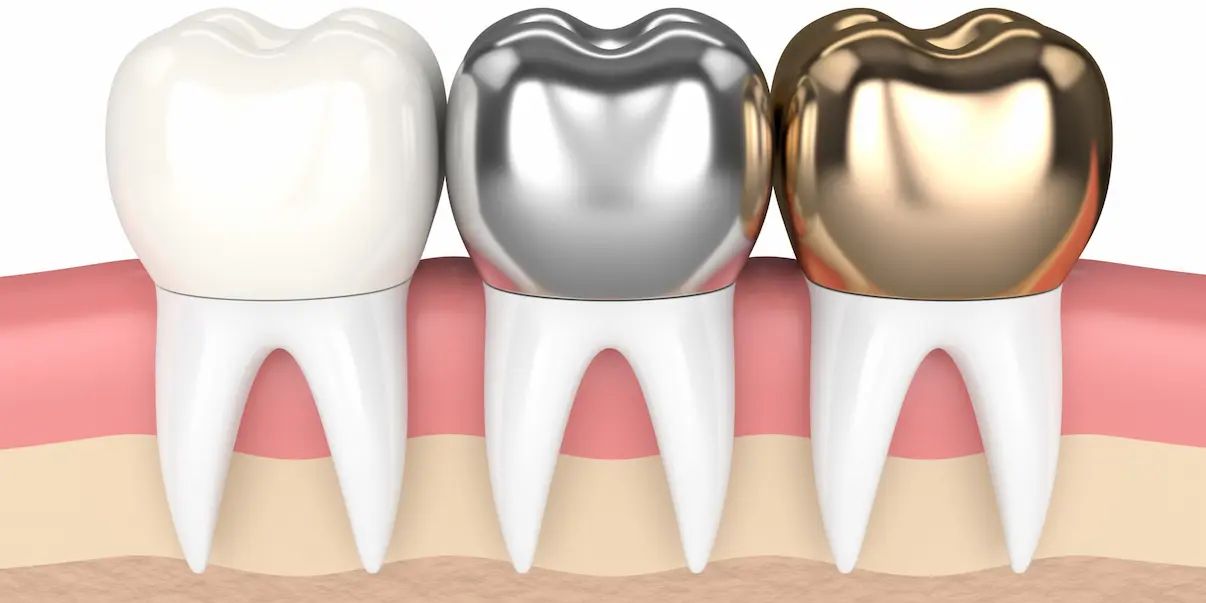Different Types Of Dental Crowns

If you have a tooth that’s damaged, your dentist might recommend covering the tooth with a dental crown.
Depending on your oral situation, different types of crowns are available to restore your tooth to its natural shape, appearance, and function.
What's a Dental Crown?
Also known as a cap, a dental crown is most often a tooth-colored prosthetic designed to cover a damaged tooth in a fixed position. Once inserted, a crown can strengthen the tooth, improving its overall appearance and alignment in the mouth.
What Can I Expect When Getting a Crown?
Unless there is other dental work involved, you’ll usually visit your dentist twice for your crown.
1st visit: Expect your dentist to:
✓ Talk to you about the various crown options, the choice of which depends on such factors as the crown’s placement, your bite, your gum tissue.
✓ Trim down the damaged tooth to make room for the crown to fit comfortably.
✓ Take an impression for the crown by having you bite into impression paste placed on your trimmed tooth. This impression will go to a dental lab that’ll prepare your crown.
✓ Insert a temporary crown until your permanent crown returns from the dental lab.
2nd visit: Your dentist will remove the temporary crown and fit the permanent one, making sure it feels right before cementing it into place.
If needed, a post may be required to build up your tooth up before placing the crown.
Ultimately, your crown should function just as your natural tooth would.
Why Would I Need a Crown?
You might require a crown for any number of reasons.
✓ Cap a damaged or decayed tooth.
✓ Strengthen a filled tooth.
✓ Protect a weak tooth.
✓ Improve a discolored tooth.
✓ Hold a dental bridge in place.
✓ Hold together a cracked tooth.
✓ Protect a tooth post-root canal.
✓ Cap a dental implant.
What are Dental Crowns Made Of?
If you’ve always wanted a golden crown, you might be able to have one – in your mouth. However, not all crown materials are mined. Some are scientifically developed or designed from other natural substances, according to the National Center for Biotechnology Information and the ADA.
Your dentist will advise you on which material – or combination of materials – will work best for you.
Porcelain-Veneered Zirconia
Pros: Strong, natural-looking, low in cost
Cons: Porcelain prone to chipping, can aggravate adjacent teeth
IPS e.max (Lithium Disilicate)
Pro: Doesn’t require porcelain veneer
Con: Not as strong or tough as other materials, usually limited to back teeth
Ceramic (porcelain crowns)
Pro: Blends best with natural tooth color to restore a front-teeth smile
Cons: Prone to chipping, can aggravate adjacent teeth, susceptible to pressure (such as grinding teeth)
Good to know: Usually limited to front teeth
Porcelain-Fused-to-Metal (PFM)
Pros: Long-term durability, provides a strong bond to teeth, the metal framework provides strength
Cons: Porcelain prone to chipping, can aggravate adjacent teeth
Gold Alloy
Pros: Strongest of materials along with base-metal alloy, doesn’t fracture or wear down teeth, gentle on adjacent teeth
Cons: Costly (copper and other metals mixed into the gold alloy), doesn’t look natural
Good to know: Looks like a gold tooth
Base-Metal Alloy
Pros: Strongest of materials along with gold alloy, doesn’t fracture or wear down teeth, gentle on adjacent teeth, highly resistant to corrosion, requires the least amount of tooth to be removed
Cons: Doesn’t look natural, can be costly
Plus, for temporary prosthetics, dentists might use resin crowns.
How Can I Maintain My Crowns?
If your crown becomes loose, falls out or chips, consult your dentist. But with proper dental health maintenance – the same oral hygiene routine you use to keep your teeth healthy – crowns can last a lifetime.
However, the goal is to avoid needing a crown, and you know how to do that. Eat foods your teeth love, floss or clean between your teeth, and brush twice daily, preferably with a toothbrush that cleans your back molars, such as one with bi-level bristles, and, as always, schedule regular checkups with your dentist.
Articles are reviewed by Dr. Arab. This information is for educational purposes only. This content is not intended to be a substitute for professional medical advice, diagnosis or treatment. Always seek advice from your dentist, doctor or other qualified health care provider.
Please let us know what you think!